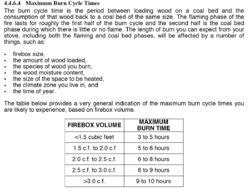I'm not having much success with the overnight burn. I'll load up before bed but when I get up in the morning the stove is cold and if I have any coals they're small and useless. I'm running a Lopi Patriot with a 1.6 cf wood box. The advertised burn time is up to 8 hours but hell if I can get it to last more than 3-4.
I'm also wondering if there's really a point to burning overnight. It seems pretty wasteful since you're burning so low, I wonder if it wouldn't be better just do your last reload in the early evening and not worry about an overnight burn. I just feel like I'm wasting wood since the stove is cold in the morning anyway.
FYI, when I DO attempt an overnight burn I go to bed with the house around 70 and get up with it around 60, when I DON'T try the overnight burn, I go to bed around 70 and get up around 55, granted our lowest outside temperature so far was 21 degrees, so that inside morning temperature might start to drop as winter sets in.
I'm also wondering if there's really a point to burning overnight. It seems pretty wasteful since you're burning so low, I wonder if it wouldn't be better just do your last reload in the early evening and not worry about an overnight burn. I just feel like I'm wasting wood since the stove is cold in the morning anyway.
FYI, when I DO attempt an overnight burn I go to bed with the house around 70 and get up with it around 60, when I DON'T try the overnight burn, I go to bed around 70 and get up around 55, granted our lowest outside temperature so far was 21 degrees, so that inside morning temperature might start to drop as winter sets in.



 , insulate/air seal, or get a much bigger stove. My house is poorly insulated and drafty as heck and 10-15 degrees is a larger swing than I've ever seen unless the stove was off all day. And as far as wasteful, just depends on the situation. I think it's much lest wasteful to keep it more constant, and keep the stove at a more efficient burn rate. The hotter the stove, like what you'd need to warm the place back up, will be wasting a lot more heat up the flue. Have you considered a bigger stove?
, insulate/air seal, or get a much bigger stove. My house is poorly insulated and drafty as heck and 10-15 degrees is a larger swing than I've ever seen unless the stove was off all day. And as far as wasteful, just depends on the situation. I think it's much lest wasteful to keep it more constant, and keep the stove at a more efficient burn rate. The hotter the stove, like what you'd need to warm the place back up, will be wasting a lot more heat up the flue. Have you considered a bigger stove?